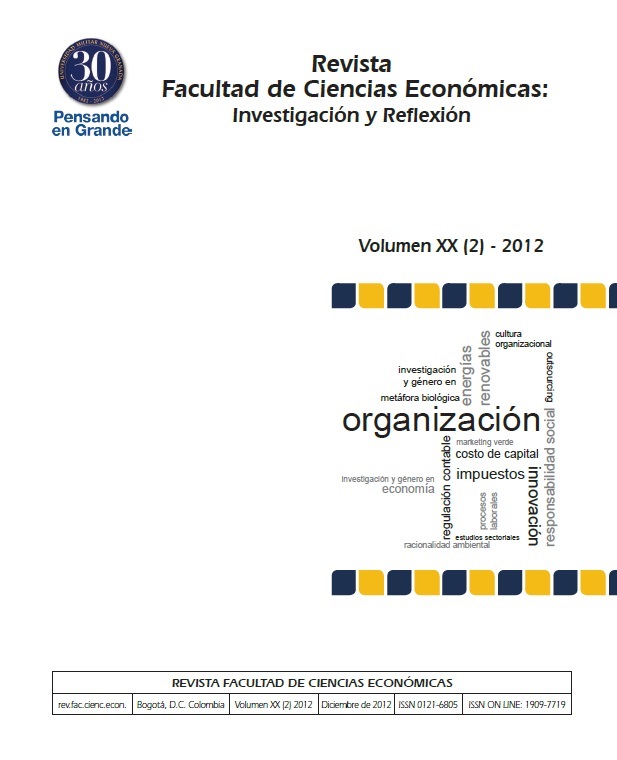As comunicações Integradas de Marketing (CIM) como pilar da estratégia de marketing verde e suas implicações na gestão ambiental
Resumo
Este documento examina a estrutura das Comunicações Integradas de Marketing (CIM), da sua definição até sua aplicação a partir da perspectiva do marketing verde na estratégia organizacional. O texto apresenta três grandes discussões: em primeiro lugar, faz uma reflexão particular sobre as contribuições e as implicações mais importantes das Comunicações Integradas de Marketing e de cada um de seus instrumentos com a estratégia da gestão ambiental das organizações. Depois, uma caracterização geral do consumidor verde e de outros stakeholders da organização, em particular, sobre seu papel no processo estratégico da comunicação verde. Finalmente, como conclusões deste trabalho são feitas algumas considerações sobre a necessária aplicação deste conceito na proposta de gestão ambiental organizacional da atualidade.Downloads
Referências
Carabaza, J., Lozano, J., González, J., Pasco L., Reyes, L., Berumen, A. & Álvarez, P (2007). Cobertura Del Medio Ambiente en la Televisión Mexicana. En: Revista Comunicación y Sociedad, Universidad de Guadalajara, Enero-Junio, 7: 45-76.
Chamorro, A., Miranda, F & Rubio, S. (2005). La investigación Académica en Marketing Ecológico: Diferencias entre las Publicaciones Españolas y las Internacionales. XVII Encuentro de profesores universitarios de marketing. Madrid, 22-23 de septiembre de 2005. ISBN 84-7356-424-3, pp. 883-902.
Chan, R. (1999). Environmental Attitudes and Behavior of Consumers in China. En: Journal of International Consumer Marketing, 11(4): 25-52.
Chan, R. & Lau, L. (2002). Explaining Green Purchasing Behavior -A Cross-Cultural Study on American and Chinese Consumers. En: Journal of International Consumer Marketing, 14(2-3): 9-40.
Chan, R. & Lau, L. (2004). The Effectiveness of Environmental Claims among Chinese Consumers: Influences of Claim Type, Country Disposition and Ecocentric Orientation. En: Journal of Marketing Management, 20(3-4): 273-319.
Cornelissen, J. & Lock, A. (2000). Theoretical concept or management fashion. Examining the significance of IMC. En: Journal of Advertising Research, 40(5): 7-15.
Duncan, T. (2002). IMC: Using Advertising and Promotion to Build Brands. International Edition, The McGraw-Hill Companies.
Duncan, T. & Everett, S. (1993). Client Perceptions Of Integrated Marketing Communications. En: Journal of Advertising Research, May/Jun, 33( 3): 30-39.
Durmaz, Y. & Zergin, S. (2011). Theoretical Approach to Concept Of Green Marketing. En: Interdisciplinary Journal of Contemporary Research in Business, 3 (2): 1808-1814.
Gould, S. (2000). The state of IMC research and applications. En: Journal of Advertising Research, 40(5): 22-23.
Hartley, B. & Pickton, D. (1999). Integrated Marketing Communications require a New way of thinking. En: Journal of marketing Communications, 5(2): 97-106
Hartmann, P. & Apaolaza-Ibáñez, V. (2009). Green Advertising Revisited. Conditioning Virtual Nature Experiences. En:International Journal of Advertising, 28(4): 715-739.
Keegan, W., Moriarty, S. & Duncan, T. (1992). Marketing. Prentice-Hall, Englewood Cliffs, NJ.
Keller, K. (2001). Mastering the Marketing Communications Mix: Micro and Macro Perspectives on Integrated Marketing Communication Programs. En: Journal of Marketing Management, 17: 819-847.
Kerr, G., Schultz, D., Patti, Ch. & Kim, I. (2008). An inside-out approach to integrated marketing communication, an international analysis. En: International Journal of Advertising, 27(4): 511-548.
Kitchen, P & Schultz, D. (1999). A Multi-Country Comparison of the Drive for IMC. En: Journal of Advertising Research, 39 (1): 21-38.
Kliatchko, J. (2005). Towards a New Definition of Integrated Marketing Communications (IMC). En: International Journal of Advertising, 24(1): 7-34.
Kliatchko, J. (2008). Revisiting the IMC construct- A revised definition and four pillars. En: International Journal of Advertising, 27(1): 133-160.
Kliatchko, J. (2009). IMC 20 Years After: A Second Look at IMC Definitions. En: Intemational Journal of Integrated Marketing Communications, 1(2): 7-12.
Kotler, P., Armstrong, G., Saunders, J. & Wong, V. (1999). Principles of Marketing. (2nd European edition). London: Prentice Hall Europe.
Lorenzo, M. (2002). Marketing Ecológico y Sistemas de Gestión Ambiental: Conceptos y Estrategias Empresariales. En: Revista Galega de Economía, 11 (2): 1-25.
Low, G. (2000). Correlates of integrated marketing communications. En: Journal of Advertising Research, 40 (3): 27-39.
Madhavaram, S., Badrinarayanan V. & McDonald, R. (2005). Integrated Marketing Communication (IMC) and Brand Identity as Critical Components of Brand Equity Strategy. En: Journal of Advertising, 34(4): 69-80.
O'guinn, T., Allen, C. & Semenik, R. (2007). Publicidad y comunicación integral de marca. 4a edición. Ed. Cengage Learning México.
Saez, C. (2005). Los Spots, una posibilidad para desarrollar la educación ambiental a través de la televisión. En:Revista Comunicar, N° 25. Grupo Comunicar, Huelva - España.
Schultz, D. (1991). Integrated Marketing Communications: The Status of Integrated Marketing Communications Programs in the US. En: Journal of Promotion Management, 1: 37-41.
Schultz, D. & Kitchen, P. (2000). A response theoretical concept or management fashion? En: Journal of Advertising Research, 40(5): 17-21
Schultz, D. & Schultz, H. (2004). IMC The next generation. Five steps for delivering value and measuring returns using marketing communications. McGraw-Hill Nueva York.
Shimp, T. (2007). Integrated marketing communications in advertising and promotion. Ed. South-Western Cengage Learning, USA.
Stafford, M., Stafford, T. & Chowdhury, L. (1996). Predispositions toward green issues: The potential efficacy of advertising appeals. En: Journal of Current Issues and Research in Advertising, 18 (1): 67-79.
Swain, W. (2004). Perceptions of IMC after a decade of development: Who's at the wheel, and how can we measure success? En: Journal of Advertising Research, 44 (1): 46-65.
Vélez, M. (2001). Situación actual en el campo del comercio de productos y servicios de la biodiversidad en la región andina. Ginebra: UNCTAD.
Zinkhan, G. & Carlson, L. (1995). Green Advertising and the Reluctant Consumer. En: Journal of Advertising, 24 (2): 1-6.











